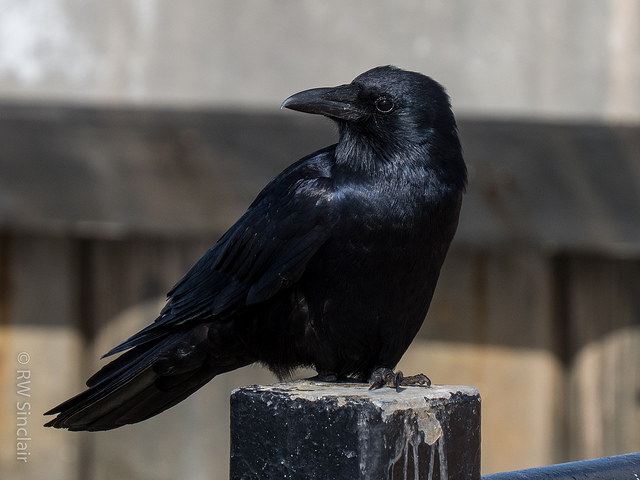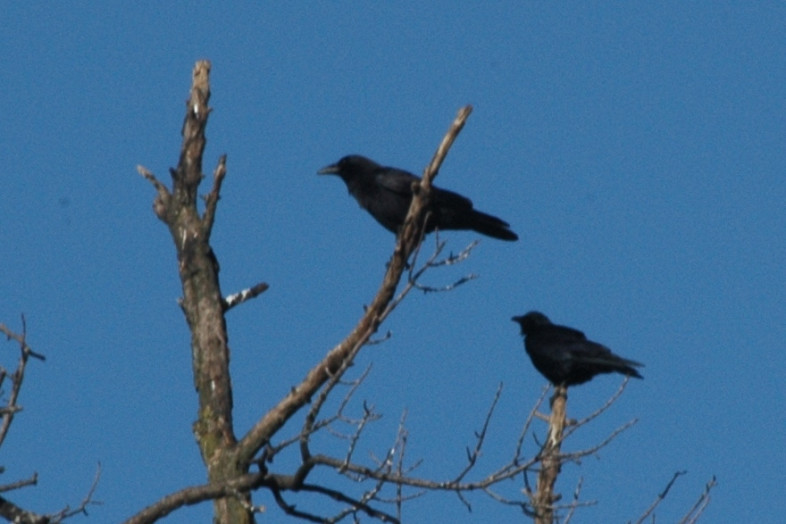Vermont has two species of crows, and one is very scarce and tricky to identify with certainty. Fish Crows are near their northern limits in Vermont. An extremely small breeding population is well known in the Burlington area. Nesting has been located only four times, the latest in 2012. Well confirmed observations of birds are mostly one or two birds at a time; rarely three or four individuals have been well identified during an observation. The 2012 nesting had two adults and three juveniles, for an unusually high count of five.
No careful study has been made of the actual numbers of Fish Crows in the Burlington area, but there are clearly very few. This past year Fish Crows were reported in Vermont eBird less than four days a month except for April (8 days) and May (13 days). The most birds reported on a single day were 5 birds in a single group on September 16th, and 4 birds (two separate groups of two on April 20th). The highest counts over a five day period were 5 birds, once each in April, May, and September. 78% of the reports were for a single bird, and 15% were for two birds. Reports were concentrated in four areas, with the maximum distance between observed Fish Crows being only eight miles.
Elsewhere in the state there have been only eight scattered instances of one or a couple of Fish Crows. Any observation away from the Burlington area requires that a Rare Species Documentation form (RSD) be submitted to the Vermont Bird Records Committee. No RSD is required for birds seen or heard in the Burlington area. However, with many birders seeking to discover Fish Crows in and around Burlington, there is a growing number of reports based on inadequate observations and detailed descriptions that would satisfactorily identify the birds as Fish Crows. Likewise, most reports of multiple birds have lacked sufficient documentation for each of the individual birds.
What should you look and listen for when you suspect a Fish Crow? Are there simple features or vocalizations that you can use? What are the common errors birders make?
To help answer these questions, we’ve developed guidelines for careful observations and adequate documentation for Vermont eBird.
- For good observation skills, birders seeking Fish Crows definitely should read this article, How do you tell a Fish Crow from an American Crow.
- If reporting a Fish Crow by vocalization alone, it is not enough to say the vocalization is nasal or at a higher pitch. In nearly all cases the vocalizing that you heard must contain the “uh-uh” phrasing. Additional remarks about the duration of the call and the character of its ending can be helpful as well.
- If size is used to determine a Fish Crow, there must be a close, side-by-side comparison with an American Crow in comparative postures. This can be difficult, and you might have to spend an extended period of time waiting for birds to get really close to each other. Size alone, without other criteria, is not adequate to determine the species.
- If physical and behavioral characteristics are used to distinguish the species consult the guidance of the article cited above, and describe what you carefully saw regarding the bird.
- When reporting multiple Fish Crows tell exactly how each individual was determined to be a Fish Crow. This can take a fair amount of effort in some circumstances. It is not unusual to fairly easily figure out that one Fish Crow is present, perhaps by hearing the uh-uh phrasing in a nasal voice …. but then can’t figure out if more than one bird is making that vocalization. The more suspected Fish Crows in an observation, the harder it becomes to document them all.
- Do not assume multiple Fish Crows seen together are a family group without some direct evidence.
All of us are familiar with crows, one of our most common bird companions. But a first-time discovery of a Fish Crow can be an exciting experience and addition to a life list. Fortunately in Vermont there are a few, but they take some work to discover. Moreover, small, isolated populations of a species near the edge of its range can be significant for the species as a whole as it responds to habitat, environmental, and climatic change. It behoves us to know our Burlington population well, and that can be facilitated with careful reporting.
Ian Worley
Vermont eBird county data editor and hotspot coordinator



Tom,
Jamie, a few years back, learned the Fish Crow call and introduced it to
me. Of course I couldn’t tell you what that call is now, but let’s focus
on learning about it and see if we see any.
You game?
Cath